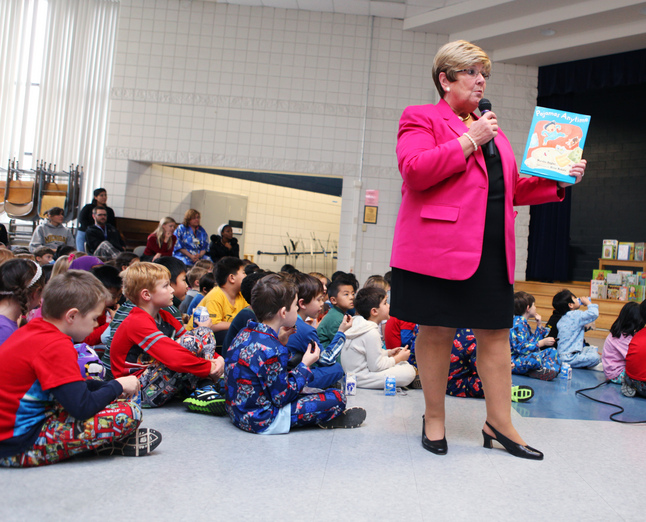
Superintendent Patricia Green reads "Pajamas Anytime" to students of Logan Elementary School in this 2011 file photo. Green said on Tuesday that school building closures are not on the table for the 2013-14 budget cycle, but will be in 2014-15.
Jeff Sainlar I AnnArbor.com file photo
Previous coverage:
Editor's note: This is the second in a two-part series stemming from an interview with Ann Arbor Superintendent Patricia Green on the district's budget. The first part, in which the superintendent pledged to take a pay cut, was published Tuesday.
As Ann Arbor Public Schools administrators wrestle with how to cut another $17 to $20 million from the district's budget, one thing not on the table for the next school year is closing school buildings, Superintendent Patricia Green said.
The district is preparing to consider several big-ticket items when it comes to reducing the district's overall operating expenses as it faces tight budgets over the next two years. Green has said previously that closing schools, redistricting and rerouting buses can no longer be ignored or treated as the elephant in the room.
But if the public expects to hear more about building closures and redistricting this budget cycle, it won't, Green said in an interview Tuesday with AnnArbor.com. The interview also included District Spokeswoman Liz Margolis and Finance Director Nancy Hoover.
Green said it could take up to 18 months to properly assess and prepare for considering school closures.
Throughout the current academic year, Green and her administrative team have been working on a series of reports on the district's capacity and enrollment trends, transportation costs, building replacement costs and maintenance of the district's physical properties.
The last time district officials permanently closed schools was in the mid-1980s, Margolis said. Seven buildings were closed at that time.
In the past five to 10 years in Washtenaw County, Lincoln, Saline, Willow Run and Ypsilanti all have been forced to close buildings due to budget cuts. But Margolis said these districts also have had declining enrollment, whereas Ann Arbor's enrollment has remained steady.
"We don't have a building that could hold another entire elementary school or half an elementary school of students," Hoover said. "We are going to have to move these students around the district. And that's why it takes a long time to look and see where they can be moved and where lines can be redrawn."
AAPS has been criticized in recent years for not seriously considering school closures. Instead, the district has cut teachers, transportation, music and arts programming and extracurricular activities in piecemeal fashion to reduce its budget. And these items all are on the chopping block again for fall, as the district faces another $17 to $20 million in cuts.
District documents show closing three elementary schools could save $1.5 million, closing a middle school could save $1 million, closing Community High School could save $1.4 million and closing a comprehensive high school could save $3 million.
"There are staff members who are involved right now in developing the action plan for the redistricting process," Green said. "It's for cost efficiency and that's the purpose of it. You don't just snap your fingers and say we're going to redistrict. It's something that takes time.
" It will be something that we'll be looking at during next year's (budget) cycle."
Zero-based budgeting
For now, Green has set her focus on keeping cuts out of the classroom as much as possible for one more year — but it's not going to be easy, she said — and on reorganizing the district's budget process.
Because personnel is the largest part of a school district's budget, employee concessions are expected to be an important component of keeping cuts out of the classroom this year, Green said. School officials said last week, the district either can operate with fewer staff or the same number of less costly staff.
Negotiations are under way with the district's unions and Green also has committed to accept a pay cut to her $245,000 salary.
"We're looking at furlough days and any compensation type of activity. ... There is nothing that is going to be pleasant. Nothing. ... What it does now is it basically starts pitting program against program and people against people," Green said.
When it comes to budgeting, district officials want to flip that process on its head and, by the 2014-15 academic year, focus the debate on justifying expenditures rather than arguing about what to cut. In doing so, administrators hope to avoid budget surprises, like one the district recently got.
At a Feb. 28 meeting, administrators told school board members the district is employing 24 more teacher assistants and five more teachers than it budgeted for this year, causing the district to be $2.5 million over budget. Green said Tuesday restructuring the district's budget and reorganizing its budget process will help prevent such over-expenditures in the future.

Robert Allen
File photo
"What I want to do is flatten the organization a little bit," Green said.
Green said most school districts use a method of budgeting called bottom-line accountability. She said the Ann Arbor Public Schools is in the process of moving away from this method to line-by-line accountability — the first step in zero-based budgeting.
"It's more of a corporate model or a business model," Green said.
The district, led by Hoover and the finance department, is in the process of changing all of its budget documents and tools to account for every expenditure under each department and building budget. Every line item in the future also will have a detailed description of how the money is being spent and on what.
For example, Green said, under the district's existing model, an expenditure such as lawn care service could fall under the broader line item of physical property maintenance. However by 2014-15, Green expects to pull out every expenditure into its own item.
"Basically it's a budget development process, but you have to go into a line-by-line format before you can get into the zero-based budgeting," Green said of the changes that are being made. "... And what it does is it identifies and prioritizes school system activities and our resources, so we know what we have, then it starts from zero and gets funded to the targeted threshold of what your funding source is going to be."
Green said when one of her previous school districts switched to zero-based budgeting, it cast a spotlight on a $300,000 line item for music programming. She said she sent the draft budget back to the program chairman numerous times for more detailed descriptions of what the money was being spent on. What turned up was $100,000 for a top-of-the-line baby grand piano.
"Well, we needed a piano but we didn't need that expensive of a piano," Green said. "So we were able to make some reductions there."
In the district's revamped budget documents and processes, a line item for contingencies will be built in for addressing budget overages and unanticipated expenditures, such as the additional teacher assistants AAPS was required to hire this year.
AAPS is contractually obligated to provide either an assistant or extra pay when the target class size for a particular grade is exceeded in a teacher's classroom. Many of the 24 unanticipated TAs also were legally required to meet the Individualized Education Plans (IEPs) for special needs students.
Green said in the future, there also will be a single, one-line item for TAs. Currently, there are about 20 line items for teacher assistants that cross three departments — instruction, human resources and finance — as well as the building making the request. Dedicating one line item specifically for TAs will allow the district to track the need from year to year, which develops trend data and helps the district better predict its needs when budgeting.
Green and her administrative team will present their budget recommendations for 2013-14 to the school board in early April.
Danielle Arndt covers K-12 education for AnnArbor.com. Follow her on Twitter @DanielleArndt or email her at daniellearndt@annarbor.com.